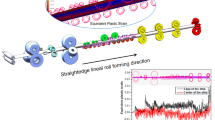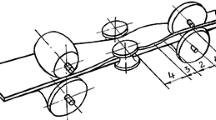Abstract
The roll forming process is applied to the manufacturing of high frequency welded (HFW) pipes, section steels, etc. In this paper, the roll forming process of the HFW pipe is simulated with the finite element method (FEM). A user-defined material routine of the commercial finite element code ABAQUS/Explicit is developed, and the mixed hardening constitution model is realized through the user-defined material routine. Based on the mixed hardening constitutive equation, the numerical simulation of roll forming process of HFW pipe is performed. The evolutions of equivalent stress and strain are analyzed, and the calculated results are also compared between different hardening models. The results show that the different material hardening models have some important effects on the variation of equivalent stress and strain of strip steel during the simulation of the roll forming process.
Similar content being viewed by others
References
Senanayake R S, Cole I M, Thiruvarudchelvan S. The application of computational and experimental techniques to metal deformation in cold roll forming [J]. Journal of Materials Processing Technology, 1994, 45: 155–160.
Heislitz F, Livatyali H, Ahmetoglu M A, et al. Simulation of roll forming processes with 3-D FEM code PAM-STAMP [J]. Journal of Materials Processing Technology, 1996, 59: 59–67.
Brunet M, Lay B, Pol P. Computer aided design of roll-forming of channel sections[J]. Journal of Materials Processing Technology, 1996, 60: 209–214.
Brunet M, Mguil S, Pol P. Modelling of a roll-forming process with a combined 2D and 3D FEM code [J]. Journal of Materials Processing Technology, 1998, 80–81: 213–219.
Hong S, Lee S, Kim N. A parametric study on forming length in roll forming [J]. Journal of Materials Processing Technology, 2001, 113: 774–778.
Alsamhan A, Hartely P, Pillinger I. The computer simulation of cold-roll-forming using FE methods and applied real time re-meshing techniques [J]. Journal of Materials Processing Technology, 2003, 142: 102–111.
Alsamhan A, Pillinger I, Hartely P. The development of real time re-meshing technique for simulating cold-roll-forming using FE methods [J]. Journal of Materials Processing Teehnology, 2004, 147: 1–9.
Kima N, Kanga B, Lee S. Prediction and design of edge shape of initial strip for thick tube roll forming using finite element method [J]. Journal of Materials Processing Technology, 2003, 142: 479–486.
Wang X C, Shao M. The principles of finite element method [M]. Beijing: Press of Tsinghua University, 1998 (in Chinese).
Jiang J M, Peng Y H, Li J X, et al. Study on FEM simulation of case roll forming of HFW pipes [J]. Chinese Mechanical Engineering, 2006, 17(Sup1): 5–9 (in Chinese).
Author information
Authors and Affiliations
Corresponding author
Additional information
Foundation item: the National Natural Science Foundation of China (No. 50375095)
Rights and permissions
About this article
Cite this article
Li, JX., Xie, LY., Wang, Jj. et al. Numerical study of the forming process of high frequency welded pipe. J. Shanghai Jiaotong Univ. (Sci.) 15, 236–240 (2010). https://doi.org/10.1007/s12204-010-8131-9
Received:
Published:
Issue Date:
DOI: https://doi.org/10.1007/s12204-010-8131-9
Key words
- numerical simulation
- mixed hardening model
- high frequency welded pipe
- cage roll forming
- user-defined material routine




